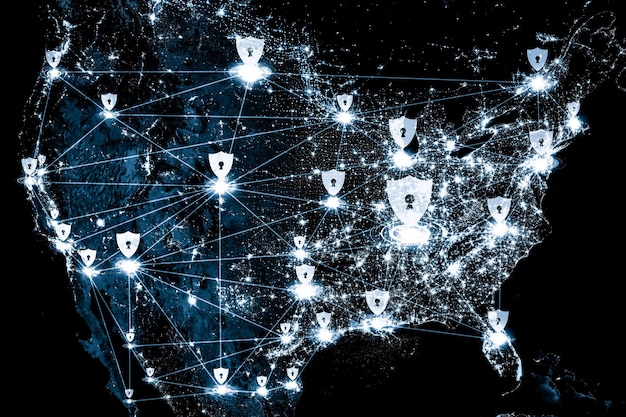How the US Will Respond to a Cyberattack on Critical Infrastructure

The US response to a cyberattack on its critical infrastructure involves a multi-layered approach, including enhanced cybersecurity measures, public-private partnerships, international cooperation, and potential offensive capabilities to deter and counter threats.
In an increasingly interconnected world, the threat of cyberattacks looms large, especially concerning a nation’s critical infrastructure. Understanding how the US will respond to a cyberattack on its critical infrastructure is crucial for businesses, policymakers, and the public alike, ensuring preparedness and resilience in the face of evolving digital threats.
Understanding the Vulnerability of US Critical Infrastructure
The United States’ critical infrastructure, which encompasses essential services such as energy, water, transportation, and communication, is increasingly reliant on digital systems. This dependence, while boosting efficiency and connectivity, also creates vulnerabilities that malicious actors can exploit. A successful cyberattack could have devastating consequences, disrupting essential services, causing economic damage, and even endangering lives.
Recognizing these risks is the first step in building a robust defense strategy. By understanding where the weak points lie, the US government and private sector can collaborate to enhance cybersecurity measures and protect vital assets.
Key Sectors at Risk
Several critical sectors are particularly vulnerable to cyberattacks due to their reliance on interconnected digital systems. These include:
- Energy: Power grids and oil pipelines are prime targets, as disruption can lead to widespread blackouts and fuel shortages.
- Water: Water treatment facilities and distribution networks are also vulnerable, threatening public health.
- Transportation: Traffic control systems and air traffic control can be compromised, leading to chaos and potential accidents.
- Communication: Telecommunication networks are essential for coordinating emergency responses and maintaining essential services.
Protecting these sectors requires a multi-faceted approach, combining advanced cybersecurity technology, robust regulatory frameworks, and ongoing vigilance.

In summary, safeguarding US critical infrastructure from cyber threats requires a deep understanding of the vulnerabilities and proactive measures to enhance digital resilience.
The National Cyber Strategy: A Framework for Response
The National Cyber Strategy serves as the foundational framework for the US’s response to cyberattacks, outlining strategic objectives and policy initiatives to protect the nation’s digital infrastructure. This strategy emphasizes a proactive approach, focusing on deterrence, defense, and resilience. By establishing clear guidelines and promoting collaboration, the strategy aims to create a more secure and resilient cyberspace.
The effectiveness of the National Cyber Strategy relies on its ability to adapt to evolving threats and foster strong partnerships between the public and private sectors.
Key Pillars of the National Cyber Strategy
The National Cyber Strategy is built upon several key pillars, each aimed at bolstering the nation’s cybersecurity posture:
- Deterrence: By making it clear that cyberattacks will be met with consequences, the US seeks to dissuade potential adversaries from launching attacks.
- Defense: Enhancing the cybersecurity of critical infrastructure through advanced technology, best practices, and incident response capabilities.
- Resilience: Ensuring that critical systems can withstand and recover from cyberattacks, minimizing disruption and economic damage.
- International Cooperation: Working with allies and partners to promote shared cybersecurity standards and combat cybercrime globally.
These pillars collectively aim to create a comprehensive and adaptive cybersecurity framework that protects US interests in the digital domain.
In conclusion, the National Cyber Strategy provides a roadmap for the US’s response to cyberattacks, emphasizing deterrence, defense, resilience, and international cooperation to secure critical infrastructure.
Government Agencies Involved in Cyber Defense
Several government agencies play critical roles in protecting US critical infrastructure from cyber threats. These agencies collaborate and coordinate their efforts to detect, prevent, and respond to cyberattacks. Understanding their respective roles is essential for comprehending the complexity and scope of the US cyber defense apparatus.
The effectiveness of these agencies depends on their ability to share information, coordinate responses, and adapt to evolving cyber threats.
Key Agencies and Their Roles
The following agencies are at the forefront of US cyber defense:
- Cybersecurity and Infrastructure Security Agency (CISA): CISA is the lead federal agency for cybersecurity, responsible for protecting critical infrastructure from physical and cyber threats.
- National Security Agency (NSA): The NSA focuses on intelligence gathering and cyber warfare, providing valuable insights into potential threats and developing offensive capabilities.
- Federal Bureau of Investigation (FBI): The FBI investigates cybercrimes and works to bring cybercriminals to justice, deterring malicious activity and holding perpetrators accountable.
- Department of Homeland Security (DHS): DHS coordinates national efforts to protect against terrorism and other threats, including cyberattacks on critical infrastructure.
These agencies work together to create a robust and coordinated cyber defense that protects the nation from a wide range of threats.

To summarize, several government agencies play vital roles in US cyber defense, collaborating to detect, prevent, and respond to cyberattacks effectively.
Public-Private Partnerships: A Collaborative Approach
Protecting US critical infrastructure from cyberattacks requires a collaborative approach that leverages the expertise and resources of both the public and private sectors. Public-private partnerships (PPPs) are essential for sharing threat information, developing best practices, and enhancing cybersecurity across all critical sectors.
The success of PPPs hinges on trust, transparency, and a shared commitment to enhancing cybersecurity. By working together, the public and private sectors can create a more secure and resilient digital ecosystem.
Benefits of Public-Private Partnerships
PPPs offer numerous benefits for enhancing cybersecurity:
- Information Sharing: Private sector companies can share threat information with government agencies, providing valuable insights into emerging threats and vulnerabilities.
- Expertise and Resources: Private sector companies often possess specialized expertise and resources that can augment government cybersecurity capabilities.
- Best Practices: PPPs can facilitate the development and adoption of best practices for cybersecurity, ensuring that all critical sectors are following the most effective security measures.
By fostering collaboration and knowledge sharing, PPPs can significantly enhance the overall cybersecurity posture of US critical infrastructure.
In conclusion, public-private partnerships are critical for protecting US critical infrastructure from cyberattacks, enabling effective information sharing, leveraging expertise, and promoting best practices.
Legal and Regulatory Frameworks for Cyber Security
The US government has established legal and regulatory frameworks to promote cybersecurity and protect critical infrastructure. These frameworks outline security standards, incident reporting requirements, and liability protections for organizations that experience cyberattacks. Compliance with these frameworks is essential for ensuring that critical infrastructure is adequately protected.
The effectiveness of these frameworks depends on their ability to adapt to evolving threats and promote a culture of cybersecurity across all critical sectors.
Key Legal and Regulatory Frameworks
Several key frameworks guide cybersecurity efforts in the US:
- Cybersecurity Act of 2015: This act promotes information sharing between the public and private sectors and provides liability protections for companies that share threat information.
- National Institute of Standards and Technology (NIST) Cybersecurity Framework: This voluntary framework provides a set of guidelines for organizations to assess and improve their cybersecurity posture.
- Sector-Specific Regulations: Various sectors, such as healthcare and finance, have their own specific cybersecurity regulations that organizations must comply with.
These frameworks collectively aim to create a robust and consistent approach to cybersecurity across all critical infrastructure sectors.
In summary, robust legal and regulatory frameworks are essential for promoting cybersecurity and protecting US critical infrastructure, ensuring compliance and enhancing overall security.
Potential Offensive Cyber Capabilities
In addition to defensive measures, the US also maintains offensive cyber capabilities as a deterrent and response option. These capabilities can be used to disrupt or disable the systems of adversaries who launch cyberattacks against US critical infrastructure. The use of offensive cyber capabilities is a complex and controversial issue, raising legal and ethical considerations.
The effectiveness of offensive cyber capabilities depends on their ability to deter attacks and respond proportionally to aggression, while avoiding unintended consequences.
Considerations for Offensive Cyber Operations
The use of offensive cyber capabilities involves several key considerations:
- Deterrence: The threat of offensive cyber action can deter potential adversaries from launching attacks in the first place.
- Proportionality: Any offensive response must be proportionate to the initial attack, avoiding escalation and unintended consequences.
- Legal and Ethical Considerations: The use of offensive cyber capabilities must comply with international law and ethical principles.
These considerations are crucial for ensuring that offensive cyber operations are used responsibly and effectively.
In conclusion, the possession and potential use of offensive cyber capabilities serve as a deterrent and response option for the US, requiring careful consideration of legal, ethical, and strategic factors.
| Key Point | Brief Description |
|---|---|
| 🛡️ Vulnerability Awareness | Recognizing digital system weaknesses is crucial for defense strategies. |
| 🤝 Public-Private Partnerships | Collaboration is key for sharing threat information and enhancing security. |
| 📜 Legal Frameworks | Regulations promote compliance and protect critical infrastructure. |
| ⚔️ Offensive Capabilities | Deterrence is achieved with the potential for proportional responses. |
Frequently Asked Questions
What are the primary goals of the US National Cyber Strategy?
The US National Cyber Strategy aims to deter cyberattacks, defend critical infrastructure, enhance resilience, and promote international cooperation to secure cyberspace.
How does CISA contribute to protecting US critical infrastructure?
CISA serves as the lead federal agency for cybersecurity, coordinating efforts to protect critical infrastructure from physical and cyber threats through risk management and incident response.
Why are public-private partnerships important for cybersecurity?
These partnerships leverage the expertise and resources of both sectors, enabling better information sharing, best practice development, and enhanced cybersecurity across vital industries.
What legal frameworks govern cybersecurity in the US?
Frameworks like the Cybersecurity Act of 2015 and the NIST Cybersecurity Framework establish guidelines and protections for organizations to improve their cybersecurity posture.
How can the US use offensive cyber capabilities to deter attacks?
By maintaining and signaling the potential use of offensive capabilities, the US can deter adversaries and respond proportionally to cyber aggression against their critical systems.
Conclusion.
In conclusion, the US response to a cyberattack on its critical infrastructure is a multifaceted effort involving enhanced cybersecurity measures, public-private partnerships, legal frameworks, and potential offensive capabilities. By strengthening defenses and promoting collaboration, the US aims to protect its vital assets and ensure resilience in the face of evolving digital threats.
Content





